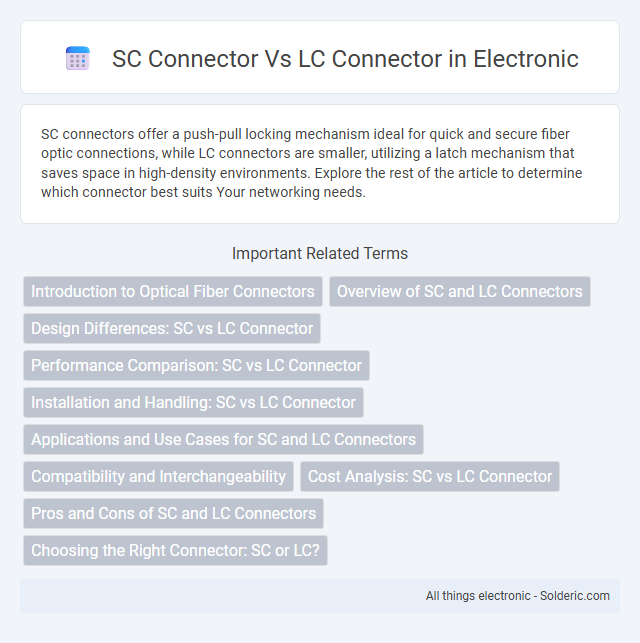SC connectors offer a push-pull locking mechanism ideal for quick and secure fiber optic connections, while LC connectors are smaller, utilizing a latch mechanism that saves space in high-density environments. Explore the rest of the article to determine which connector best suits Your networking needs.
Comparison Table
| Feature | SC Connector | LC Connector |
|---|---|---|
| Full Name | Subscriber Connector | Lucent Connector |
| Connector Size | 13.4 mm x 4.4 mm | 6.25 mm x 3.2 mm |
| Insertion Loss | Typically 0.25 dB | Typically 0.15 dB |
| Type | Push-pull, snap-in | Latching tab (similar to RJ-45) |
| Application | Single-mode and multimode fiber, patch panels | High-density fiber patch panels, transceivers |
| Ferrule Size | 2.5 mm | 1.25 mm |
| Density | Standard density | High density (compact) |
| Common Usage | Telecom, datacom older installations | Modern datacom, LANs, and SANs |
Introduction to Optical Fiber Connectors
SC (Subscriber Connector) and LC (Lucent Connector) connectors represent two of the most widely used optical fiber connectors in telecommunications and data networks. SC connectors feature a push-pull locking mechanism with a 2.5mm ferrule, offering robust connections primarily in single-mode fiber applications, while LC connectors use a smaller 1.25mm ferrule and latch mechanism, making them ideal for high-density patch panels and duplex configurations. Both types provide low insertion loss, excellent return loss performance, and compatibility with various fiber optic cables, but LC connectors are favored for space-saving and high-precision environments.
Overview of SC and LC Connectors
SC connectors feature a push-pull locking mechanism and are popular for their durability and ease of use in high-density network environments. LC connectors are smaller with a latch mechanism, enabling higher port density and commonly used in data centers and telecom equipment. Your choice between SC and LC connectors depends on space requirements and device compatibility.
Design Differences: SC vs LC Connector
SC connectors feature a square-shaped design with a push-pull locking mechanism, making them robust and easy to connect and disconnect in high-density environments. LC connectors are smaller, with a compact form factor and a latch mechanism, ideal for high-density fiber optic installations requiring minimal space. The SC connector's larger size suits single-mode and multimode applications, while the LC connector's miniaturized design supports higher port density and improved cable management.
Performance Comparison: SC vs LC Connector
SC and LC connectors differ significantly in performance metrics such as insertion loss and return loss, with LC connectors typically offering lower insertion loss around 0.1 dB compared to SC connectors' 0.2 dB, making LC ideal for high-density environments. The LC connector's smaller form factor enhances performance in space-constrained applications without compromising signal integrity, while SC connectors provide robust performance with ease of installation. Choosing the right connector depends on your network's density requirements and performance targets, with LC connectors often preferred for high-speed, high-density fiber optic networks.
Installation and Handling: SC vs LC Connector
SC connectors feature a push-pull locking mechanism that offers easy and secure installation, optimal for quick deployments in high-density environments. LC connectors, being smaller with a latch locking mechanism, provide superior flexibility and precision in handling, ideal for compact spaces requiring high port density. Both connector types support simple installation, but LC connectors demand more careful handling due to their smaller size and delicate ferrules.
Applications and Use Cases for SC and LC Connectors
SC connectors are widely used in data centers and telecom networks due to their robust push-pull design and high-density fiber patch panels. LC connectors, favored in high-performance computing and enterprise environments, support higher port density and are ideal for small form-factor transceivers. Your choice between SC and LC connectors should align with the specific application requirements, such as space constraints and network speed demands.
Compatibility and Interchangeability
SC connectors feature a push-pull locking mechanism providing secure connections widely used in telecom and data networks, while LC connectors utilize a smaller form factor ideal for high-density patch panels and SFP transceivers. Both connectors use standard single-mode or multimode fibers, but their ferrule sizes differ (SC: 2.5mm, LC: 1.25mm), impacting direct physical compatibility and requiring adapter hybrids for interconnecting. Despite serving similar purposes in fiber optic systems, SC and LC connectors are not interchangeable without specialized adapters due to differing connector dimensions and mounting styles.
Cost Analysis: SC vs LC Connector
SC connectors typically cost less than LC connectors due to their larger size and simpler design, which also makes them easier to manufacture and install. LC connectors are more compact and support higher-density applications, often justifying their higher price in data centers and telecom environments where space saving is critical. Choosing between SC and LC connectors depends on balancing the initial cost against long-term scalability and performance needs in fiber optic networks.
Pros and Cons of SC and LC Connectors
SC connectors offer robust push-pull locking mechanisms that ensure reliable connections and are ideal for high-density applications, but they are bulkier compared to LC connectors. LC connectors provide a smaller form factor with improved port density, making them suitable for space-constrained environments, though their latch mechanism can be more delicate and prone to damage. Choosing between SC and LC connectors depends on balancing durability and ease of use (SC) against compact size and higher density (LC) for specific fiber optic network requirements.
Choosing the Right Connector: SC or LC?
SC connectors offer a push-pull locking mechanism ideal for high-density networking applications, supporting multimode and single-mode fibers with reliable low insertion loss. LC connectors feature a smaller form factor with a latch mechanism, making them suitable for ultra-high density environments and improving port density in data centers. Select SC connectors for ease of use and robust physical connection, while LC connectors are preferred for space-saving needs and higher-density patch panels.
SC Connector vs LC Connector Infographic

 solderic.com
solderic.com